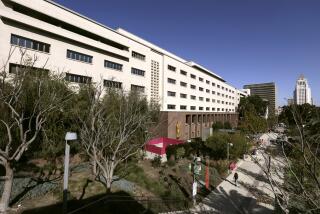Man Slain by Police Had Been Trying to Turn Life Around
- Share via
The defendants in the civil wrongful-death suit were the city of Long Beach, its Police Department and five of its officers. Yet, as the weeks of testimony unfolded this summer, it often seemed that the young man police had killed--during a mistaken-identity pursuit--was the one on trial.
Day after day, the character and troubled life of John Francis Jordan were dissected for the jury as witnesses answered questions about everything from his friends and his job to his stint in state prison.
Jurors on Friday sided with the city, finding 10 to 2 that the officers who had shot Jordan to death had neither used unreasonable force nor acted negligently.
According to his family and friends, Jordan was well on the road to leaving his past behind when he was killed three years ago. They said he had mended once-frayed family ties and had held a steady job for the first time in his 26 years; he was even talking about finally finishing high school.
He was excited about his girlfriend’s pregnancy--it would be his second child--and the couple planned to marry soon. Drug use and other criminal activity were behind him, they said.
“He was no angel, but he was really turning his life around, and he sure didn’t deserve to die like that,” said Jordan’s uncle, Mike Jordan. Mike Jordan drove his ailing brother, Gregory--John’s father--to the Los Angeles County courtroom in Compton daily and sat with him through weeks of testimony.
But the attorney defending the suit and the witnesses he called to the stand painted a very different picture of John Francis Jordan: that of a drug user and a white supremacist prison gang member who had been far from mending his ways.
At least two witnesses said he had been acting high on the night of the shooting, and the coroner reported having found methamphetamines in Jordan’s body. After several months as a model employee at a Carson electric cord company, Jordan had been fired a short time before the shooting for excessive absences.
“This was one nogoodnik, who basically was the architect of his own demise,” said William A. Reidder, senior deputy city attorney for Long Beach. He said Jordan wanted to commit “suicide by cop” rather than face the prospect of more time behind bars.
Police, Reidder said, had reason to believe Jordan had a gun with him on the night they shot him as he ran through yards and over fences in a tidy, blue-collar neighborhood of North Long Beach. Police did not find a weapon on Jordan’s body, however, or along the nearly four-block route of the chase. (During the trial, Reidder tried to establish that a friend of Jordan’s had found a gun on a rooftop and hidden it from authorities, a theory hotly disputed by the Jordans’ attorneys.)
Although the trial did not draw much media attention, it came during a summer of heightened police criticism caused by several incidents. There was, for example, the videotaped beating of a 16-year-old boy by an Inglewood police officer.
And in Long Beach, civil rights groups were demanding justice for two African American women shot to death by police in separate incidents; each woman had been wielding a knife.
Glenda Lee Rymer, 49, died after being hit with a “less lethal” bean bag shot as police tried to disarm her outside her apartment in June 2001.
In January, police shot mentally ill Marcella Byrd, 57, after she left a market without paying for groceries and raised an 8-inch knife toward officers as they followed her, commanding her to drop the knife. Police said the bean bags they fired initially had had no effect.
“This Southern California law enforcement environment is unbelievable to me. It’s almost like an occupying force,” said William J. Clough, a Jordan attorney and former police officer.
The Jordan family suit, brought two years ago by Gregory Jordan on behalf of his son’s children, Justin now 10, and Jahni, now 2, and Jahni’s mother, sought $10 million.
John Jordan died shortly after 8 p.m. Sept. 3, 1999, shot as he tried to scale a fence after eluding police, and their periodic shots, for nearly half an hour. Officers said he was reaching for his waistband, leading them to believe he was going for a gun.
About 20 officers had joined the chase on foot, along with three police dog units and a police helicopter, which kept its light on Jordan as he emerged from a hiding spot and resumed running. Officers had fired more than 20 shots; some of the bullets lodged in nearby homes and garages.
Jordan had been spending that Friday evening hanging out with others at a friend’s bungalow on East Washington Street. Authorities said the bungalow was familiar to police as a “drug house.” Two trial witnesses testified that there had been at least one gun on the premises that night.
Police said they were looking for an armed-robbery suspect named Troy Cunningham when they went to the house after a report of drug use there.
Cunningham was a muscular man, more than 6 feet tall and weighing 200 pounds or more, with long, light-colored hair. Jordan was considerably smaller--5 feet 7, according to a company physical he received a few months earlier--and had close-cropped dark hair.
But when officers saw Jordan--apparently afraid of being arrested--jump out a rear window and take off running, they said they believed he was Cunningham, armed and dangerous.
The woman who lived in the house testified that she had told officers the fleeing man was not Cunningham.
Attorney Clough and his partner, Ralph D. Hughes, another former policeman, contended that sloppy police work and a “cavalier” attitude had led to what they described as the “completely unjustifiable” shooting death of a man who was not wanted for any crime.
“John Jordan was the victim here, not the bad guy,” said Lennie Harris of the October 22 Coalition to Stop Police Brutality, a national organization trying to call attention to cases such as Jordan’s.
Long Beach officials investigated the shooting and found it to be justified. The district attorney’s office, which reviewed the Long Beach report, concurred.
But Gregory Jordan, a former diesel machinist at the Port of Long Beach who spent the day after the shooting scouring the neighborhood for witnesses, persisted. Despite a series of back surgeries and other health problems, he joined activists seeking justice in other police incidents, and handed out pamphlets and spoke at a demonstration during the Democratic National Convention in Los Angeles. A few days later, he filed his lawsuit.
“I’d never seen this side of the Police Department,” Gregory Jordan said outside the courthouse one recent day during a lunch break.
“This has really taken a toll on us ... and just when John had started to turn things around,” Jordan said.
John and his older brother were born in Long Beach. Their parents split when they were small, and the boys lived with their mother. She died after a short bout with cancer when the boys were teenagers, and John seemed to take her death especially hard, John’s father said.
“I saw a real change in him about then,” Gregory Jordan said. John, never a strong student, dropped out of David Starr Jordan High School. He became a father at 18; his girlfriend died, also of cancer, when their son was just a few months old, Gregory Jordan said.
There were scrapes with the law: driving under the influence, auto theft, drug use, court records show. In 1993 he was sentenced to state prison for methamphetamine possession and illegally having a firearm: a .22-caliber handgun. In prison he joined a white supremacist gang known as the Nazi Low Riders and wore its tattoos.
His family said he joined the gang, not because of racism, but for protection. That he did not have the tattoos removed after prison was a sign, the city contended in court, that he had not been serious about turning over a new leaf.
But Gregory Jordan said his son had kept the tattoos covered around the family and at work. The supervisor at the firm where John Jordan worked as a warehouseman for several months said he had never seen the tattoos or any other sign of Jordan’s troubled past.
“He was a good worker, got along with everybody,” the supervisor, Hector Trigueros, said in an interview. He said he had been puzzled when Jordan, after getting a leave of absence, declined to return to work, forcing his termination.
In many ways, Gregory Jordan said, the last months of his son’s life were the happiest. Father and son had reconciled after a long estrangement. John was again close to his older brother, who had helped him find a job. He was attending family gatherings, spending time with his son and looking forward to the birth of his next child, his father said.
The father cannot understand what the son was doing on East Washington Street that night, let alone why he had run from police.
“He had told us he was tired of getting in trouble, and he was on his way to a better life,” he said. “I don’t know; maybe he just got caught up in a party situation.”
More to Read
Sign up for Essential California
The most important California stories and recommendations in your inbox every morning.
You may occasionally receive promotional content from the Los Angeles Times.











